Fettuccine Alfredo is one of those dishes that seems fancy but is secretly simple. You don’t need to be a professional chef or have a kitchen full of gadgets to make it happen. At its core, it’s just pasta tossed in a buttery, creamy sauce with a generous helping of grated cheese. That’s it. But the magic lies in how all those basic ingredients come together. It’s rich without being heavy, indulgent without trying too hard. Whether you’re cooking for a date night, a weeknight dinner, or just treating yourself, this recipe is one of those sure things that always hits right.
There’s something timeless about Fettuccine Alfredo. It doesn’t lean on trends or flashy ingredients. It sticks to a few simple things done well—and sometimes, that’s all you need. In this guide, we’ll break down exactly how to make it, share tips that make a difference, and even suggest pairings, variations, and seasonal twists. Whether you’ve never made it before or you’re just looking to upgrade your version, this one’s for you.
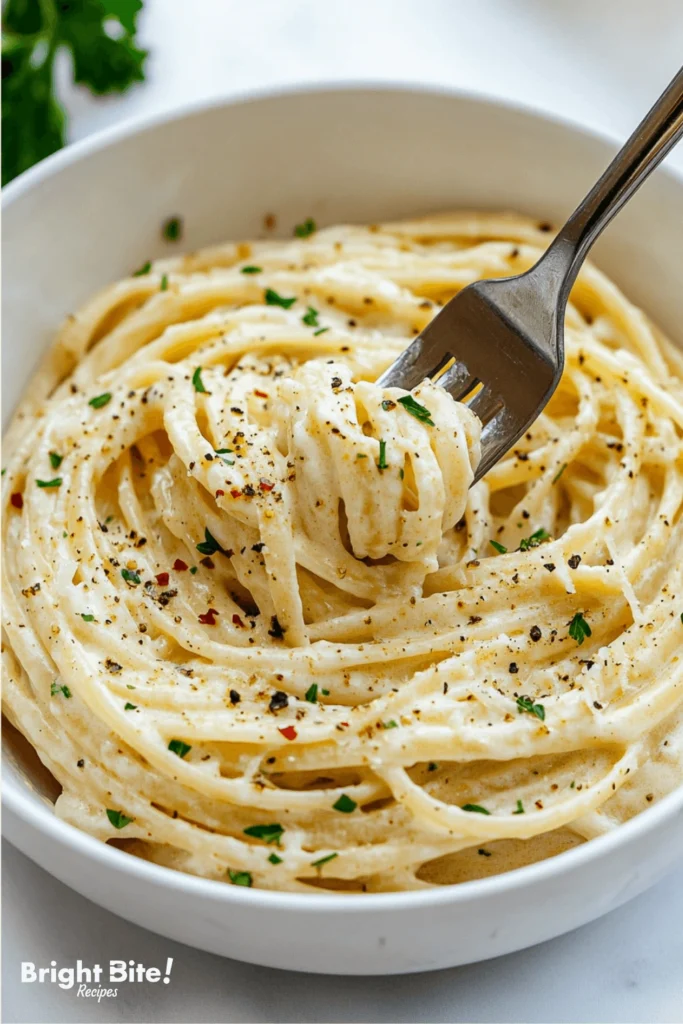
Table of Contents
Why You’ll Love This Recipe
This version of Fettuccine Alfredo brings all the comfort of the original without any unnecessary extras. It respects the traditional roots of the dish while keeping it accessible for the home cook. Here’s why it stands out:
- It’s fast. You can go from craving to eating in about the same time it takes to boil pasta.
- Minimal ingredients. Butter, cheese, cream, pasta—done. No fillers, no fluff.
- Velvety texture. The sauce coats every strand of fettuccine perfectly without being gloopy or greasy.
- Custom-friendly. Want to add grilled chicken, shrimp, or roasted veggies? Go for it. The base is flexible.
- Crowd-pleaser. Even picky eaters and non-cookers appreciate this dish. It feels special without being intimidating.
If you’re tired of overly complicated dinner ideas, this is your chance to slow down and make something satisfying. Not everything needs twenty ingredients or a trip to three different stores. Fettuccine Alfredo gets it right with less.
Detailed Ingredients and Instructions
Let’s get into the step-by-step process. This is a dish where every choice matters—from the type of cheese you use to how you cook the pasta. Here’s how to make it right.
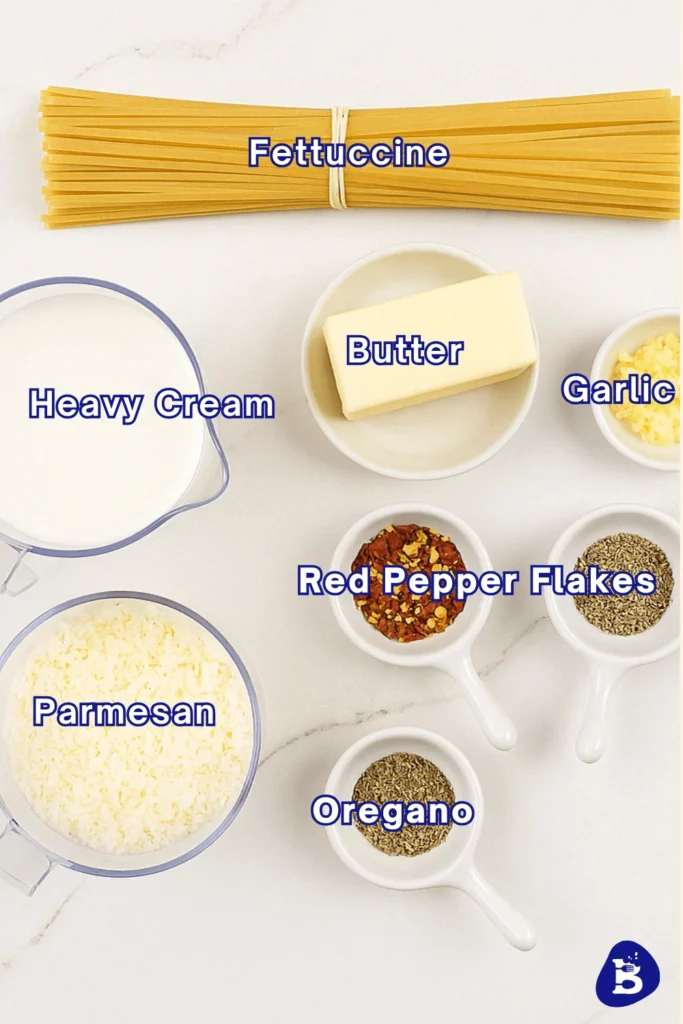
Choosing the Right Pasta:
Start with good-quality fettuccine. It’s thick enough to stand up to a rich sauce and hold onto all that creamy goodness. Fresh pasta works great here, but if you’re using boxed, just be sure to salt your water well and don’t overcook it.
Cooking the Pasta:
Boil your water, salt it generously (think ocean levels), and drop in the fettuccine. Stir occasionally so it doesn’t stick. Cook until it’s just shy of al dente. Why? Because it’s going to finish cooking in the sauce, and that’s where the real flavor gets absorbed.
Building the Sauce:
The core of Fettuccine Alfredo is simple. Melt butter in a large pan over medium-low heat. You don’t want it to brown—just melt gently. Add heavy cream and stir. Let it simmer for a few minutes until it thickens slightly. Then, add freshly grated Parmesan cheese, stirring constantly so it melts into a smooth, silky sauce.
Marrying the Pasta and Sauce:
Now for the important part—bringing everything together. Drain the pasta, but save some of that starchy pasta water. It’s liquid gold and can help loosen the sauce if it gets too thick. Toss the pasta into the pan with the sauce and stir gently until each strand is coated. Add a splash of pasta water if needed to get that glossy, restaurant-style finish.
Final Touches:
Finish with a bit more Parmesan, a crack of black pepper, and maybe a little chopped parsley for color if you’re feeling fancy. That’s it. No tricks, no shortcuts. Just solid technique and good ingredients.

Tips, Variations, and Storage Options
If you want your Fettuccine Alfredo to be more than just decent—if you want it actually to impress—these are the things that make a difference. It’s not about reinventing the wheel. It’s about small tweaks that elevate the basics.
Tips for Success:
- Use freshly grated cheese. Pre-shredded Parmesan often contains anti-caking agents that can make the sauce grainy. Grating your own ensures a smoother finish.
- Low and slow is the way. Don’t blast the heat when making the sauce. Gentle heat keeps the cream from separating and the cheese from clumping.
- Stir constantly. As the cheese melts, keep stirring to help it emulsify into the sauce. This creates that silky, even texture that makes Alfredo great.
- Reserve your pasta water. A couple of spoonfuls can fix a sauce that’s too thick or dry. It’s one of those little tricks that restaurant chefs swear by.
Variations to Try:
Fettuccine Alfredo is a blank canvas. Once you’ve mastered the base, there are plenty of ways to change things without messing it up.
- Add protein. Grilled chicken, shrimp, or even crispy pancetta pair well with the creamy sauce. Cook them separately and add them just before serving.
- Toss in veggies. Broccoli, peas, or mushrooms add color and cut through the richness. Roast or sauté them before adding to the pasta.
- Switch the cheese. Try mixing in Pecorino Romano for a sharper bite or even a bit of Gruyère for depth.
- Infuse the cream. Simmer a garlic clove or a sprig of thyme in the cream before adding the cheese, then remove it. It’s a subtle touch that makes a big impact.
Storage and Reheating:
Let’s be real—Fettuccine Alfredo is best fresh. But if you’ve got leftovers, here’s how to make the most of them.
- Refrigeration: Store in an airtight container for up to two days. The sauce will thicken as it cools.
- Reheating: Gently warm it in a pan over low heat with a splash of milk or cream. Microwaving can work, but you’ll need to stir and check often to avoid drying it out.
- Avoid freezing. Cream-based sauces tend to separate when thawed. If you’re planning meals, prep the components and combine them fresh.
Equipment Needed
You don’t need fancy gear to make Fettuccine Alfredo, but having the right basics helps things go smoothly. Here are a few tools that make a real difference in execution.
- Large sauté pan: A wide pan gives you space to toss the pasta in the sauce without making a mess. Nonstick or stainless steel both work.
- Pasta pot: A deep pot for boiling pasta evenly. Bonus points if it has a strainer insert.
- Cheese grater: A microplane or box grater works best for grating Parmesan fresh.
- Tongs or pasta fork: Helps with tossing and serving without breaking the noodles.
- Measuring cups: These are especially useful for reserving pasta water or portioning cream.
That’s pretty much it. No need for immersion blenders, food processors, or fancy gadgets. These are just solid, reliable kitchen tools that you probably already have.
Related Recipes
If you love Fettuccine Alfredo, there’s a good chance you’ll enjoy these dishes too. They hit that same comforting, creamy vibe while offering something a little different.
- Cajun Chicken Alfredo: A bold twist on the classic, with smoky, spicy Cajun-seasoned chicken. Same creamy base, but with a fiery flavor upgrade.
- Chicken Carbonara: Rich and creamy like Alfredo, but with smoky bacon and a silky egg-based sauce.
- Shrimp Scampi Pasta: A lighter, lemon-forward option that still delivers on indulgence without the dairy-heavy base.
- Baked Ziti with Ricotta and Mozzarella: Different pasta, oven-baked style, but still riding the creamy cheese wave.
- Pesto Alfredo Hybrid: Mix pesto into the Alfredo base for a herby twist that keeps things fresh and green.
All of these are crowd-pleasers, and most follow a similar cooking flow—boil pasta, make sauce, and toss together. If you’re feeling stuck in a recipe rut, these are great ways to branch out without venturing too far.
Pairing/Serving Suggestions
Fettuccine Alfredo is rich, creamy, and comforting — which means it pairs well with dishes that offer contrast. Think crisp textures, bright flavors, or lighter elements that balance out the decadence.
Simple Side Dishes That Work:
- Garlic bread: A crunchy slice of garlic bread or a toasted baguette is a no-brainer. It’s great for soaking up leftover sauce.
- Mixed greens salad: Go with something sharp and lemony. Arugula, baby kale, or romaine tossed with a light vinaigrette cuts right through the creaminess.
- Roasted veggies: Asparagus, broccoli, or Brussels sprouts add a bit of char and crunch that offsets the soft pasta.
- Caprese salad: Fresh tomatoes, mozzarella, and basil drizzled with balsamic glaze bring a cool, refreshing contrast.
Drink Pairings That Don’t Overpower:
- White wine: Go with a crisp Pinot Grigio, Sauvignon Blanc, or an unoaked Chardonnay. These wines cleanse the palate without competing.
- Sparkling water or lemonade: If you’re skipping the alcohol, a lemon-forward drink balances the richness nicely.
- Light beer: A pilsner or pale ale won’t clash with the cream sauce and helps reset the palate between bites.
Desserts to Finish the Meal:
You’re probably full, but if you want something sweet, make it light.
- Lemon sorbet or gelato: A refreshing way to end the meal without going overboard.
- Vanilla panna cotta: Creamy but not too heavy. Kind of a full-circle moment if you’re into matching tones.
- Fresh berries: Served on their own or with a dollop of whipped cream, they’re easy and won’t tip you into food coma territory.
Whether you’re planning a cozy dinner for two or a small dinner party, building the right plate around your Fettuccine Alfredo makes the whole experience better.
Frequently Asked Questions
Even though Fettuccine Alfredo is a simple recipe, it comes with its fair share of questions. Here are some of the most common ones — answered straight-up, no fluff.
Can I make it without cream?
You can, but it won’t be quite the same. Some traditional versions use just butter and Parmesan with pasta water. It works, but it’s lighter and less rich than what most people expect from modern Alfredo. Try it if you want something a bit less heavy.
Why did my sauce separate or turn grainy?
This usually happens if you use pre-shredded cheese or if the heat is too high. Always melt cheese slowly over low heat and stir consistently. Stick with freshly grated Parmesan for the best results.
Is it okay to use milk instead of cream?
You can use whole milk, but the sauce will be thinner. To thicken it slightly, you can add a bit of flour or cornstarch to the butter before adding the milk — creating a quick roux. It’s not traditional, but it works in a pinch.
Can I make it ahead of time?
Technically, yes. But the sauce tends to thicken and lose its smooth texture as it sits. If you have to prep ahead, keep the pasta and sauce separate until ready to serve, and reheat gently with extra liquid.
Is it gluten-free?
The sauce itself is naturally gluten-free, assuming you’re not adding flour. Just use gluten-free pasta and double-check your cheese for additives.
What protein goes best with it?
Grilled chicken is a classic choice. Shrimp is another favorite. Both bring a mild flavor that doesn’t compete with the sauce. If you want to go bolder, crispy prosciutto or seared scallops are great upgrades.
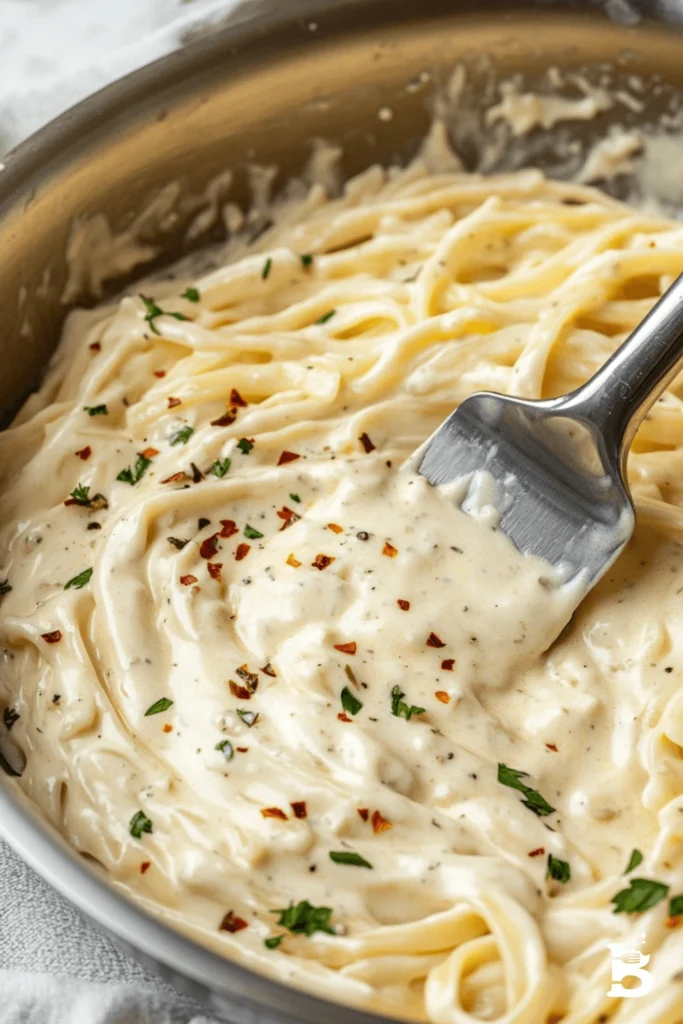
Nutrition Information
Let’s talk about what’s actually in a serving of Fettuccine Alfredo. Keep in mind this will vary depending on your exact ingredients and portions, but here’s a general breakdown for one serving:
- Calories: Around 650 to 700
- Protein: Roughly 15 to 18 grams
- Carbohydrates: About 50 to 60 grams
- Fat: Around 40 grams (with a good mix of saturated and unsaturated)
- Fiber: Minimal unless you add veggies or use whole-wheat pasta
- Sugar: Very low, depending on the cream and cheese
This isn’t diet food — and it’s not trying to be. It’s a once-in-a-while kind of indulgence or a way to make a weeknight feel a little more special. If you’re counting macros or calories, you can adjust portion sizes or use lighter ingredients, but the classic version is all about comfort.
Seasonal and Occasion Variations
One of the best things about Fettuccine Alfredo is how easy it is to adapt it to the season or occasion without losing its identity. Here’s how to keep it fresh year-round or make it feel right for a special meal.
Spring Touches:
Add peas, asparagus tips, or sautéed leeks for brightness and a pop of color. Fresh herbs like tarragon or chives work well stirred in at the end. These ingredients lighten up the dish without dulling its richness.
Summer Vibes:
Keep it cool and simple. Pair with grilled zucchini, cherry tomatoes, or even a bit of lemon zest for extra brightness. If it’s hot outside, consider serving smaller portions with a chilled salad to balance things out.
Fall Comfort:
Lean into the cozy factor with roasted butternut squash cubes or caramelized onions. A pinch of nutmeg in the sauce can add warm depth without overpowering. Serve alongside roasted root veggies or a spiced cider.
Winter Upgrade:
For heartier meals, add sautéed mushrooms, truffle oil, or crispy pancetta. These flavors match the depth of winter foods and help turn a simple bowl of Fettuccine Alfredo into a full-on comfort feast.
Occasions Worth Celebrating:
- Date Night: Dress it up with grilled scallops or a crisp glass of wine. Dim lights. You’re golden.
- Dinner Party: Prep your sauce and pasta separately and combine just before serving for a stress-free but impressive dish.
- Holiday Gatherings: Serve it as a luxe side dish next to a roast or turkey. It’s a crowd-pleaser that fits right in with holiday spreads.
- Birthdays or Anniversaries: A richer dish like this deserves a moment. Serve it in smaller portions as a pasta course or the main dish with a fun topping like black pepper shrimp or herbed chicken.
You don’t have to change much to make Fettuccine Alfredo fit a mood or season. It’s flexible enough to dress up or down without losing what makes it great.
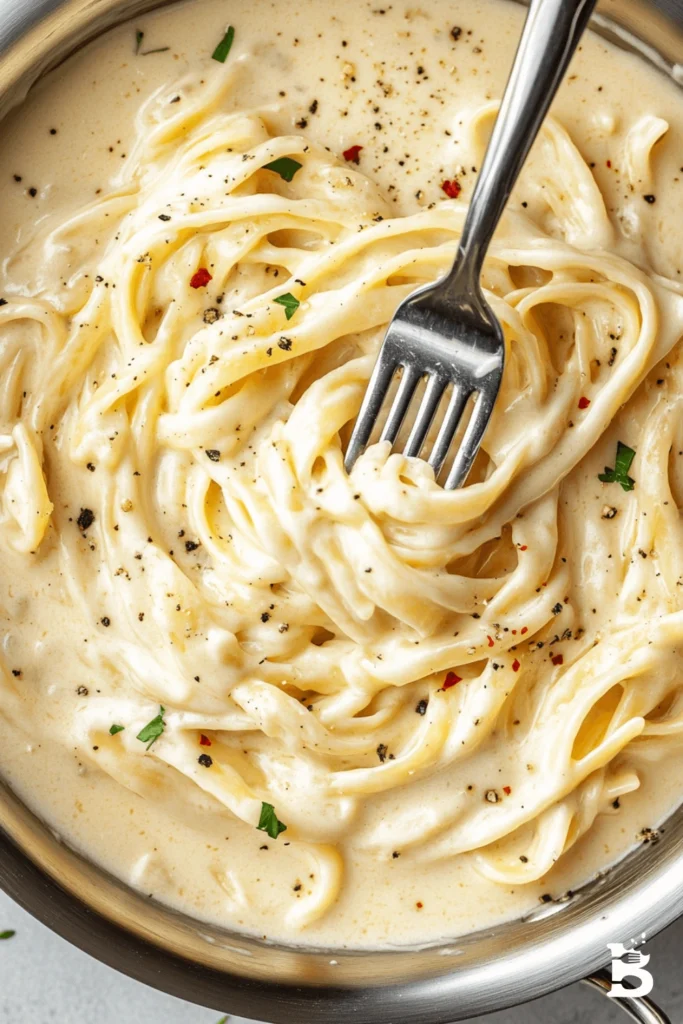
My Recipe Tips
Here’s the real talk — the things I’ve learned from making this recipe too many times to count. Some are small details, but they genuinely affect how the final dish turns out.
- Don’t walk away. The sauce needs attention. Stir it while it simmers. Stir it while you add the cheese. This keeps it from separating and helps it stay smooth.
- Pasta water is your friend. Don’t forget to reserve a cup before draining. Even if you think you won’t need it — just do it. It’s one of those habits that saves dishes more often than not.
- Salt in stages. Don’t dump in a bunch at the end. Salt your pasta water generously, taste the sauce after adding cheese, and only add extra if needed. Parmesan brings its saltiness.
- Cheese quality matters. You don’t need the fanciest wedge, but avoid the pre-bagged stuff if you can. Freshly grated cheese melts better and tastes richer.
- Serve right away. This isn’t a dish that waits. The sauce thickens fast as it cools, so get it to the table while it’s hot and glossy.
Bonus Tip: If you want to prep the meal, cook the pasta and make the sauce separately. Store them in containers and combine them when reheating with a splash of cream or milk. This gives you a fresh texture without the gummy mess leftovers can sometimes become.
Conclusion
Fettuccine Alfredo isn’t trendy. It’s not trying to reinvent anything. And that’s what makes it so reliable. It’s just a creamy, buttery, cheesy bowl of pasta that always delivers. Whether you’re making it for the first time or have it on a regular dinner rotation, there’s comfort in its consistency.
But beyond being simple, it’s a reminder that good food doesn’t need to be complicated. When the ingredients are solid and the method is sound, you don’t need much else. Just a good pot, a block of cheese, and twenty or thirty minutes of your time.
So next time you’re staring into your pantry wondering what to make — or when you want something that feels like a hug in food form — give this classic a shot. And when you do, don’t forget the garlic bread.
If you enjoyed this recipe, check out some of the related pasta ideas listed above — or explore more comfort food classics that are just as easy to pull off with real ingredients and a little bit of care.
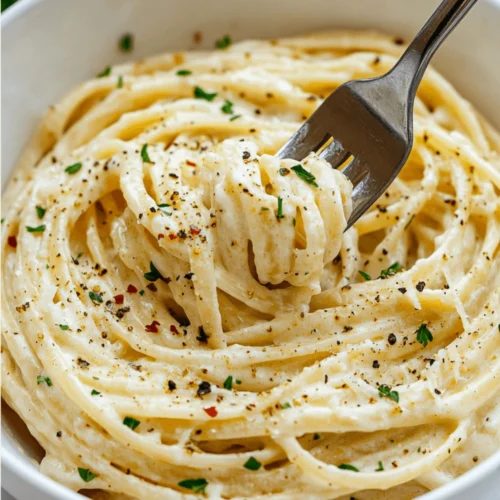
🍝 Fettuccine Alfredo 🍽️✨
Ingredients
- 12 oz fettuccine pasta
- 1 tablespoon olive oil
- 1/2 cup unsalted butter
- 1 cup heavy cream
- 2 cups freshly grated Parmesan cheese
- 1 teaspoon garlic powder
- Salt and pepper to taste
- 1 tablespoon fresh parsley chopped (optional, for garnish)
Instructions
- Cook the pasta: Bring a large pot of salted water to a boil. Cook the fettuccine according to the package directions, typically 8-10 minutes, until al dente. Drain the pasta, reserving 1/2 cup of pasta water for later use.
- Make the sauce: In a large skillet, heat olive oil over medium heat. Add the butter and allow it to melt. Once the butter has melted, add the heavy cream and bring it to a gentle simmer. Let it simmer for 2-3 minutes, stirring occasionally.
- Add cheese and seasonings: Gradually whisk in the Parmesan cheese, garlic powder, salt, and pepper. Continue to stir until the sauce thickens and becomes smooth and creamy, about 3-5 minutes.
- Combine pasta and sauce: Add the cooked fettuccine to the sauce, tossing to coat the pasta evenly. If the sauce is too thick, gradually add reserved pasta water, a little at a time, until the desired consistency is reached.
- Serve: Plate the fettuccine Alfredo and sprinkle with fresh parsley, if desired. Serve immediately and enjoy!
